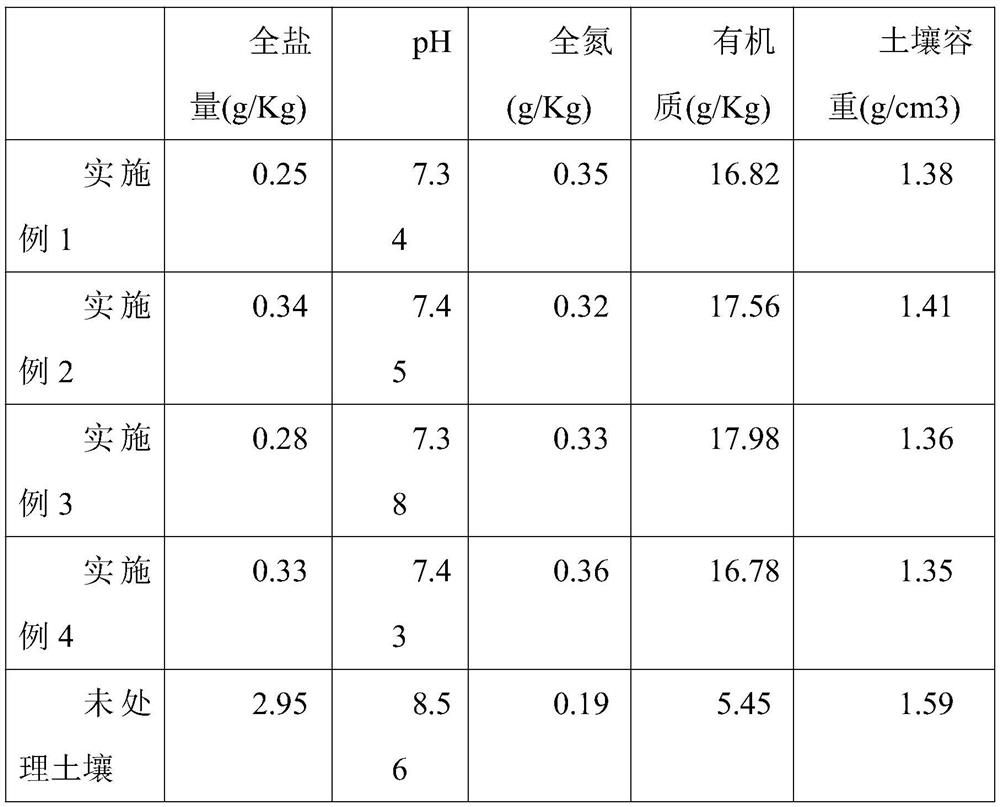A method for biological improvement of saline-alkali soil
A saline-alkali land and soil technology, which is applied in the direction of soil preparation methods, soil conditioning materials, chemical instruments and methods, etc., can solve the problems of large-scale implementation difficulties, short service life, and long improvement cycle, and achieve the suppression of fungi, nematodes, and plant root diseases and insect pests , save cost, improve the effect of soil compaction
- Summary
- Abstract
- Description
- Claims
- Application Information
AI Technical Summary
Problems solved by technology
Method used
Image
Examples
Embodiment 1
[0027] A method for biologically improving saline-alkali soil, comprising the following steps:
[0028] (1) Deep plow and loosen the saline-alkali land for soil-breaking treatment, with a depth of 25-35 cm, and expose to the sun for 5 days;
[0029] (2) apply soil improver, deep plowing and deep loosening again and turn over the soil, the depth of soil breaking is 25-35cm; process for 10 days; the soil improver is 40 parts of bio-organic fertilizer, 40 parts of desulfurized gypsum, 20 parts of humic acid, 15 parts of EDTA chelated zinc, 4 parts of potassium dihydrogen phosphate, 5 parts of wood vinegar, 45 parts of plant ash, 15 parts of kaolin, 18 parts of water retaining agent;
[0030] (3) the acidity regulator is applied to the soil of step (2) with water at a concentration of 5%, and water is poured thoroughly until the water penetrates into the surface layer and is slightly dry; the amount of the acidity regulator citric acid is until 10-20cm deep pH reaches below 8.0; ...
Embodiment 2
[0035] A method for biologically improving saline-alkali soil, comprising the following steps:
[0036] (1) Deep plow and loosen the saline-alkali land for soil-breaking treatment, the depth of the soil-breaking is 25-35cm, and expose to the sun for 4 days;
[0037] (2) Apply soil improver, deep plowing and deep loosening again and turn over the soil, the depth of soil breaking is 25-35cm; process for 8 days; the soil improver is 30 parts of bio-organic fertilizer, 35 parts of desulfurized gypsum, 20 parts of humic acid, 15 parts of EDTA chelated zinc, 4 parts of potassium dihydrogen phosphate, 5 parts of wood vinegar, 45 parts of plant ash, 5 parts of kaolin, 16 parts of water retaining agent;
[0038] (3) the acidity regulator is applied to the soil of step (2) with water at a concentration of 10%, and water is poured thoroughly until the water penetrates into the surface layer and is slightly dry; pH reaches below 8.0;
[0039] (4) continue to apply microbial inoculum and t...
Embodiment 3
[0042] A method for biologically improving saline-alkali soil, comprising the following steps:
[0043] (1) Deep plow and loosen the saline-alkali land for soil-breaking treatment, the depth of the soil-breaking is 25-35cm, and expose to the sun for 4 days;
[0044] (2) apply soil improver, deep plowing and deep loosening again and turn over the soil, the depth of soil breaking is 25-35cm; process for 7 days; the soil improver is 35 parts of bio-organic fertilizer, 35 parts of desulfurized gypsum, 20 parts of humic acid, 15 parts of EDTA chelated zinc, 4 parts of potassium dihydrogen phosphate, 5 parts of wood vinegar, 45 parts of plant ash, 5 parts of kaolin, 17 parts of water retaining agent;
[0045] (3) the acidity regulator is applied to the soil of step (2) with water at a concentration of 0.5%, and water is poured thoroughly until the water penetrates into the surface layer and is slightly dry; pH reaches below 8.0;
[0046] (4) continue to apply microbial inoculum an...
PUM
 Login to View More
Login to View More Abstract
Description
Claims
Application Information
 Login to View More
Login to View More - Generate Ideas
- Intellectual Property
- Life Sciences
- Materials
- Tech Scout
- Unparalleled Data Quality
- Higher Quality Content
- 60% Fewer Hallucinations
Browse by: Latest US Patents, China's latest patents, Technical Efficacy Thesaurus, Application Domain, Technology Topic, Popular Technical Reports.
© 2025 PatSnap. All rights reserved.Legal|Privacy policy|Modern Slavery Act Transparency Statement|Sitemap|About US| Contact US: help@patsnap.com

